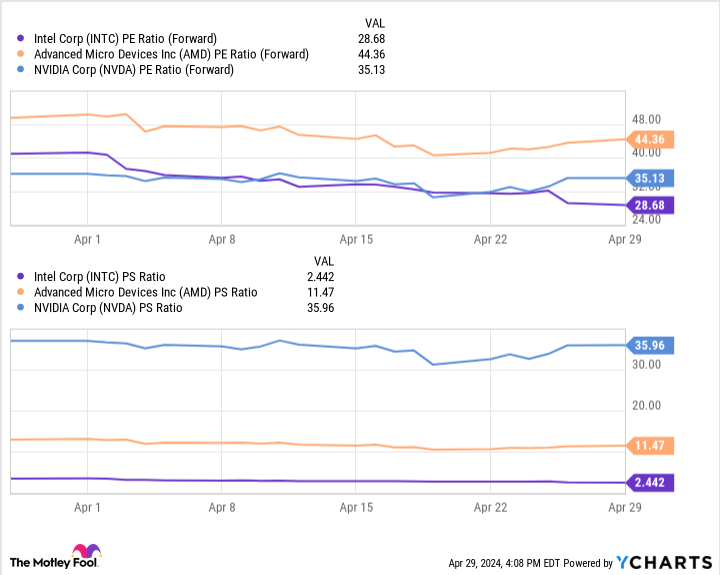Intel (NASDAQ: INTC) was once the world’s leading chipmaker. The company dominated the central processing unit (CPU) market and held lucrative partnerships with tech titans like Apple. However, a series of missteps and market changes have seen Intel’s stock tumble 46% in the last three years.
In recent years, the company has posted multiple quarters of revenue declines alongside dwindling market share in the chip sector. Intel has finally returned to revenue growth, posting gains in its fourth quarter of 2023 and the first quarter of 2024. Yet, investors remain wary of its stock. Rising competitors like Nvidia and Advanced Micro Devices threaten Intel’s future in budding markets like AI.
However, the company seeks to separate itself from these chipmakers by adopting an internal foundry model similar to how Taiwan Semiconductor Manufacturing Company operates. It’ll take time for Intel to see significant earnings growth from this transition, but it could be worth investing in the company at one of its lowest positions to profit from its potential comeback.
Here’s why Intel’s stock is a buy for investors willing to hold for the very long term.
A dismal quarterly release
On April 25, Intel released its Q1 2024 earnings. During the quarter, revenue rose 9% year over year to $13 billion yet missed analysts’ forecasts by about $80 million. Non-GAAP (adjusted) earnings per share (EPS) came to $0.18, beating expectations by $0.04.
However, growth and better-than-expected EPS weren’t enough to rally investors, with Intel’s stock dipping 14% since posting its Q1 earnings.
Intel disappointed with weak guidance for its current quarter (Q2 2024). For the second quarter, the company expects to achieve earnings of $0.10 per share on sales of $13 billion. Comparatively, Wall Street expected EPS of $0.25 and $13.6 billion in revenue.
Intel’s CEO Pat Gelsinger reiterated the company’s long-term potential, saying, “We are one of two, maybe three, companies in the world that can continue to enable next-generation chip technologies.” Taiwan Semi is the other obvious name on his list, followed by a “perhaps” for Samsung.
Q1 2024 was the first to include income from Intel Foundry, its new manufacturing division. The segment posted revenue of just over $4 billion, down 10% year over year. Meanwhile, operating losses came to $2.5 billion, compared to the $7 billion in losses reported in 2023.
However, Counterpoint analyst Akshara Bassi points out, “Running a foundry is a capital-intensive business. That’s why most of the competitors are fabless; they are more than happy to outsource it to TSMC.” Intel expects foundry losses to peak in 2024 and break even by the end of 2030.
Intel is moving in the right direction, but its stock will require patience
Intel’s transition to a foundry-first company will be costly. However, the company expects the change to help reduce costs and save between $8 billion and $10 billion by 2025. Meanwhile, increased efficiencies are projected to see Intel achieve non-GAAP gross margins of 60%.
Furthermore, Intel won’t be alone in covering the costs of its foundry business. The company is a leading recipient of President Biden’s CHIPS Act, an initiative to expand the United States’ semiconductor manufacturing capabilities. The program has earmarked $8.5 billion for Intel to build at least four facilities across the country.
Government funds have already begun to be dispersed, with the Biden administration announcing in April that Samsung would receive just over $6 billion to build out its chip manufacturing capacity. It’s still early days for the initiative, with experts projecting it to be 2027 or 2028 before U.S.-built chips make their way into mainstream consumer use. However, it’s a promising direction for Intel.
Perhaps the only positive development in Intel’s tumbling stock price is that its shares are potentially the best-valued option in the chip market. Nvidia and AMD’s recent rallies have seen their stock prices skyrocket over the last year.
The chart above shows Intel has the lowest forward price-to-earnings ratio and price-to-sales ratio out of these three chipmakers by a significant margin. These figures suggest Intel’s stock is trading at a bargain compared to AMD or Nvidia.
As a result, anyone looking to add a chip stock to their portfolio would probably do well to make a long-term investment in Intel now while they wait for Nvidia and AMD to come down to a more attractive price point.
Should you invest $1,000 in Intel right now?
Before you buy stock in Intel, consider this:
The Motley Fool Stock Advisor analyst team just identified what they believe are the 10 best stocks for investors to buy now… and Intel wasn’t one of them. The 10 stocks that made the cut could produce monster returns in the coming years.
Consider when Nvidia made this list on April 15, 2005… if you invested $1,000 at the time of our recommendation, you’d have $544,015!*
Stock Advisor provides investors with an easy-to-follow blueprint for success, including guidance on building a portfolio, regular updates from analysts, and two new stock picks each month. The Stock Advisor service has more than quadrupled the return of S&P 500 since 2002*.
*Stock Advisor returns as of April 30, 2024
Dani Cook has no position in any of the stocks mentioned. The Motley Fool has positions in and recommends Advanced Micro Devices, Apple, Nvidia, and Taiwan Semiconductor Manufacturing. The Motley Fool recommends Intel and recommends the following options: long January 2025 $45 calls on Intel and short May 2024 $47 calls on Intel. The Motley Fool has a disclosure policy.
Is Intel Stock a Buy? was originally published by The Motley Fool
Source Agencies


